Corporate Governance Report: Gender Diversity, Ethics, and Performance
VerifiedAdded on 2020/09/08
|16
|4608
|387
Report
AI Summary
This report delves into the critical aspects of corporate governance, emphasizing the significance of gender diversity and ethical practices within organizations. It begins by highlighting the increasing pressure on companies to improve governance systems, particularly in light of the decreasing presence of women on boards. The report analyzes how gender diversity on company boards can positively impact financial performance, citing research that supports the notion that diverse teams bring varied perspectives and improve decision-making. It further discusses the importance of ethical codes of conduct in preventing illegal activities and fostering a fair and honest work environment. The report provides recommendations for implementing gender diversity policies, including establishing measurable objectives and securing commitment from top management. The report also stresses the need for a balance between men and women to provide different ideas to expand the business and recommends the appointment of women on boards as an effective way for the company to improve their financial performance. The report provides the conclusion that gender diversity is important at the workplace to create a makes bottom line sense for running the business.

Corporate Governance
1
1
Paraphrase This Document
Need a fresh take? Get an instant paraphrase of this document with our AI Paraphraser
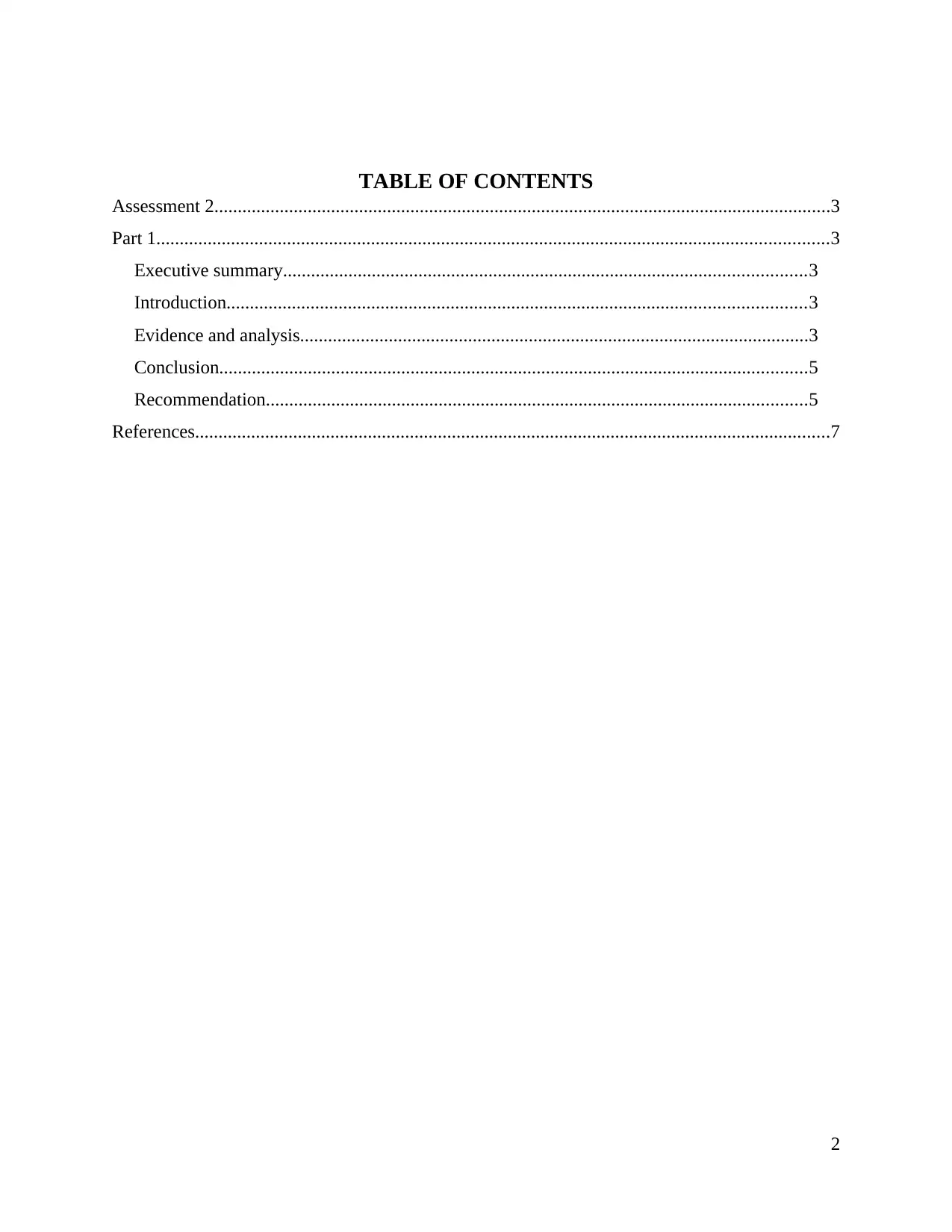
TABLE OF CONTENTS
Assessment 2....................................................................................................................................3
Part 1................................................................................................................................................3
Executive summary................................................................................................................3
Introduction............................................................................................................................3
Evidence and analysis.............................................................................................................3
Conclusion..............................................................................................................................5
Recommendation....................................................................................................................5
References........................................................................................................................................7
2
Assessment 2....................................................................................................................................3
Part 1................................................................................................................................................3
Executive summary................................................................................................................3
Introduction............................................................................................................................3
Evidence and analysis.............................................................................................................3
Conclusion..............................................................................................................................5
Recommendation....................................................................................................................5
References........................................................................................................................................7
2
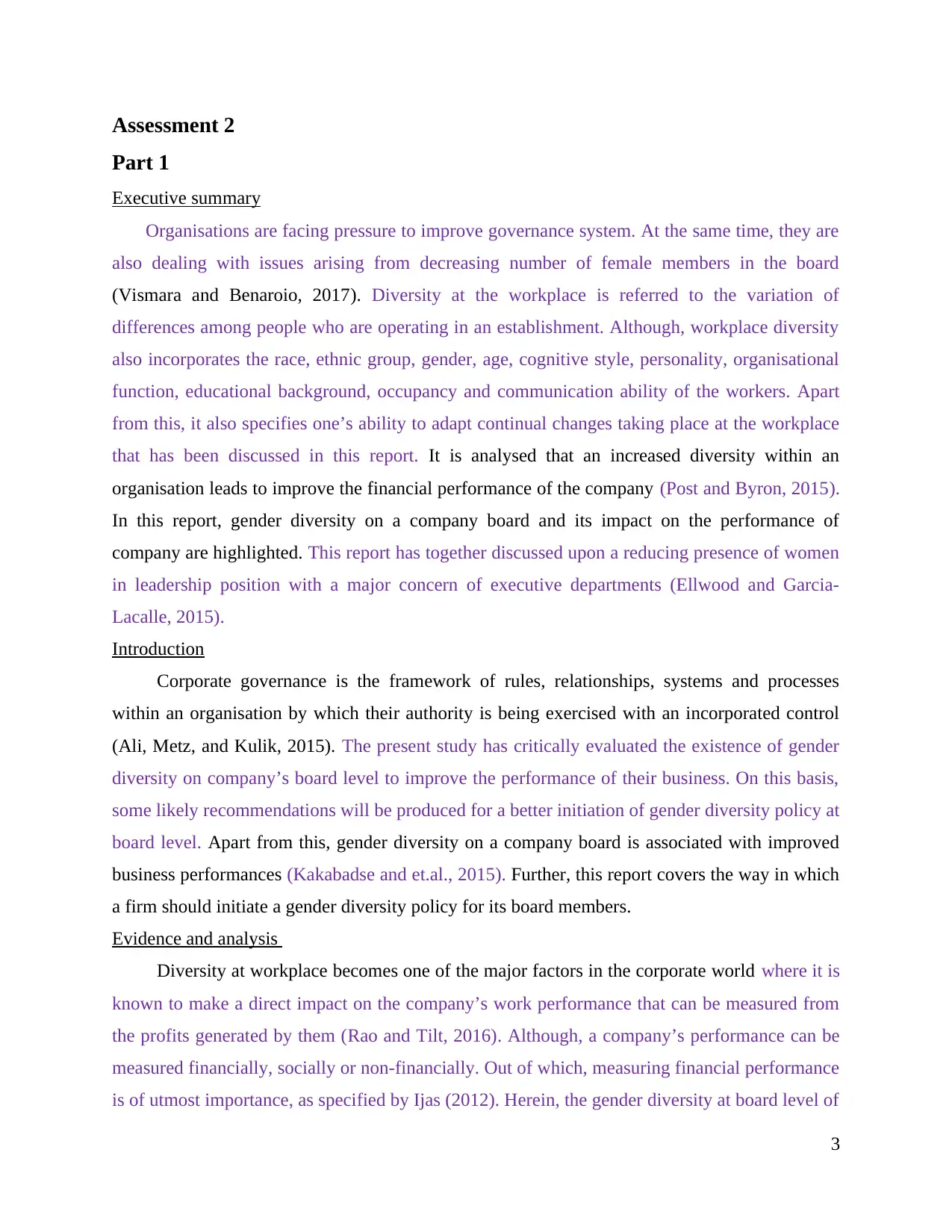
Assessment 2
Part 1
Executive summary
Organisations are facing pressure to improve governance system. At the same time, they are
also dealing with issues arising from decreasing number of female members in the board
(Vismara and Benaroio, 2017). Diversity at the workplace is referred to the variation of
differences among people who are operating in an establishment. Although, workplace diversity
also incorporates the race, ethnic group, gender, age, cognitive style, personality, organisational
function, educational background, occupancy and communication ability of the workers. Apart
from this, it also specifies one’s ability to adapt continual changes taking place at the workplace
that has been discussed in this report. It is analysed that an increased diversity within an
organisation leads to improve the financial performance of the company (Post and Byron, 2015).
In this report, gender diversity on a company board and its impact on the performance of
company are highlighted. This report has together discussed upon a reducing presence of women
in leadership position with a major concern of executive departments (Ellwood and Garcia-
Lacalle, 2015).
Introduction
Corporate governance is the framework of rules, relationships, systems and processes
within an organisation by which their authority is being exercised with an incorporated control
(Ali, Metz, and Kulik, 2015). The present study has critically evaluated the existence of gender
diversity on company’s board level to improve the performance of their business. On this basis,
some likely recommendations will be produced for a better initiation of gender diversity policy at
board level. Apart from this, gender diversity on a company board is associated with improved
business performances (Kakabadse and et.al., 2015). Further, this report covers the way in which
a firm should initiate a gender diversity policy for its board members.
Evidence and analysis
Diversity at workplace becomes one of the major factors in the corporate world where it is
known to make a direct impact on the company’s work performance that can be measured from
the profits generated by them (Rao and Tilt, 2016). Although, a company’s performance can be
measured financially, socially or non-financially. Out of which, measuring financial performance
is of utmost importance, as specified by Ijas (2012). Herein, the gender diversity at board level of
3
Part 1
Executive summary
Organisations are facing pressure to improve governance system. At the same time, they are
also dealing with issues arising from decreasing number of female members in the board
(Vismara and Benaroio, 2017). Diversity at the workplace is referred to the variation of
differences among people who are operating in an establishment. Although, workplace diversity
also incorporates the race, ethnic group, gender, age, cognitive style, personality, organisational
function, educational background, occupancy and communication ability of the workers. Apart
from this, it also specifies one’s ability to adapt continual changes taking place at the workplace
that has been discussed in this report. It is analysed that an increased diversity within an
organisation leads to improve the financial performance of the company (Post and Byron, 2015).
In this report, gender diversity on a company board and its impact on the performance of
company are highlighted. This report has together discussed upon a reducing presence of women
in leadership position with a major concern of executive departments (Ellwood and Garcia-
Lacalle, 2015).
Introduction
Corporate governance is the framework of rules, relationships, systems and processes
within an organisation by which their authority is being exercised with an incorporated control
(Ali, Metz, and Kulik, 2015). The present study has critically evaluated the existence of gender
diversity on company’s board level to improve the performance of their business. On this basis,
some likely recommendations will be produced for a better initiation of gender diversity policy at
board level. Apart from this, gender diversity on a company board is associated with improved
business performances (Kakabadse and et.al., 2015). Further, this report covers the way in which
a firm should initiate a gender diversity policy for its board members.
Evidence and analysis
Diversity at workplace becomes one of the major factors in the corporate world where it is
known to make a direct impact on the company’s work performance that can be measured from
the profits generated by them (Rao and Tilt, 2016). Although, a company’s performance can be
measured financially, socially or non-financially. Out of which, measuring financial performance
is of utmost importance, as specified by Ijas (2012). Herein, the gender diversity at board level of
3
⊘ This is a preview!⊘
Do you want full access?
Subscribe today to unlock all pages.

Trusted by 1+ million students worldwide
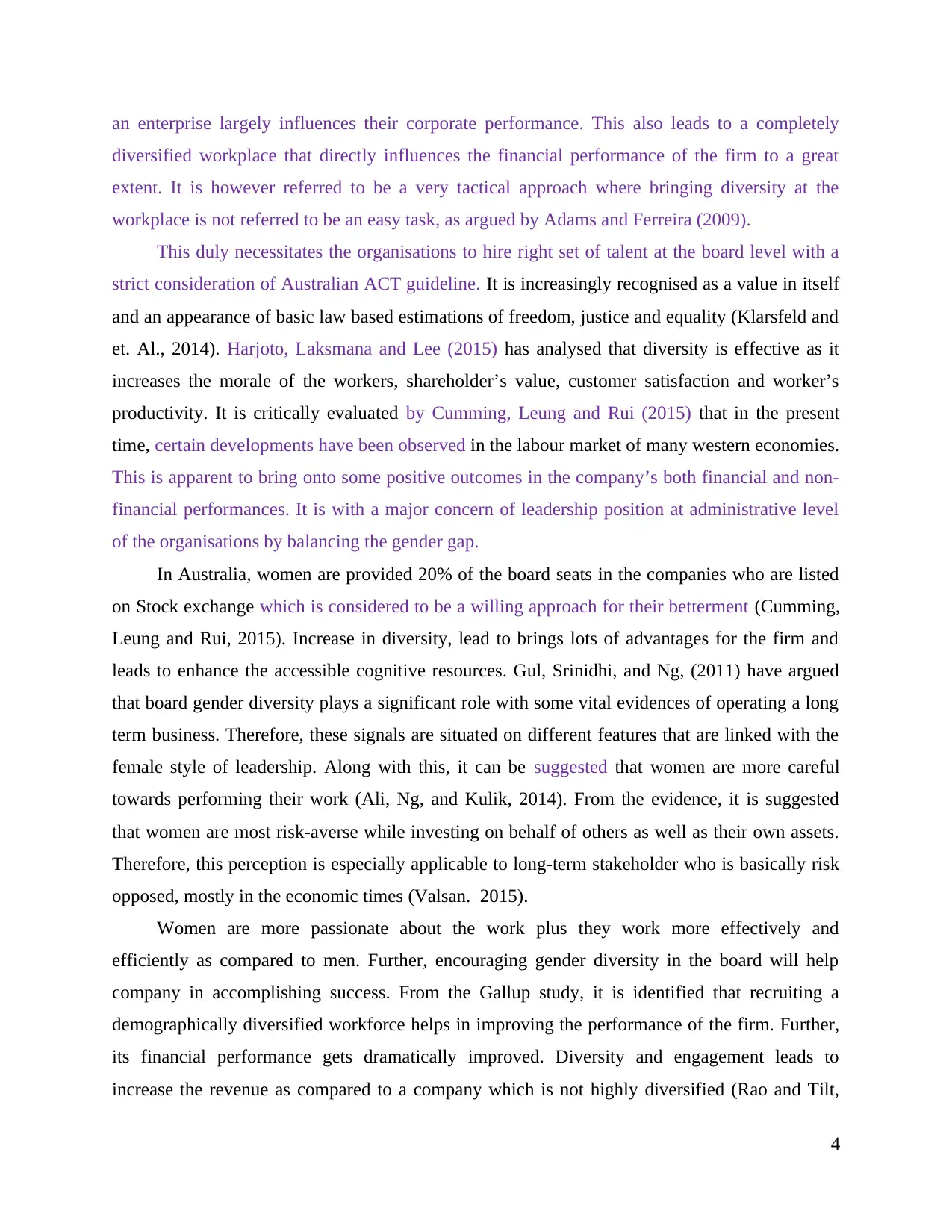
an enterprise largely influences their corporate performance. This also leads to a completely
diversified workplace that directly influences the financial performance of the firm to a great
extent. It is however referred to be a very tactical approach where bringing diversity at the
workplace is not referred to be an easy task, as argued by Adams and Ferreira (2009).
This duly necessitates the organisations to hire right set of talent at the board level with a
strict consideration of Australian ACT guideline. It is increasingly recognised as a value in itself
and an appearance of basic law based estimations of freedom, justice and equality (Klarsfeld and
et. Al., 2014). Harjoto, Laksmana and Lee (2015) has analysed that diversity is effective as it
increases the morale of the workers, shareholder’s value, customer satisfaction and worker’s
productivity. It is critically evaluated by Cumming, Leung and Rui (2015) that in the present
time, certain developments have been observed in the labour market of many western economies.
This is apparent to bring onto some positive outcomes in the company’s both financial and non-
financial performances. It is with a major concern of leadership position at administrative level
of the organisations by balancing the gender gap.
In Australia, women are provided 20% of the board seats in the companies who are listed
on Stock exchange which is considered to be a willing approach for their betterment (Cumming,
Leung and Rui, 2015). Increase in diversity, lead to brings lots of advantages for the firm and
leads to enhance the accessible cognitive resources. Gul, Srinidhi, and Ng, (2011) have argued
that board gender diversity plays a significant role with some vital evidences of operating a long
term business. Therefore, these signals are situated on different features that are linked with the
female style of leadership. Along with this, it can be suggested that women are more careful
towards performing their work (Ali, Ng, and Kulik, 2014). From the evidence, it is suggested
that women are most risk-averse while investing on behalf of others as well as their own assets.
Therefore, this perception is especially applicable to long-term stakeholder who is basically risk
opposed, mostly in the economic times (Valsan. 2015).
Women are more passionate about the work plus they work more effectively and
efficiently as compared to men. Further, encouraging gender diversity in the board will help
company in accomplishing success. From the Gallup study, it is identified that recruiting a
demographically diversified workforce helps in improving the performance of the firm. Further,
its financial performance gets dramatically improved. Diversity and engagement leads to
increase the revenue as compared to a company which is not highly diversified (Rao and Tilt,
4
diversified workplace that directly influences the financial performance of the firm to a great
extent. It is however referred to be a very tactical approach where bringing diversity at the
workplace is not referred to be an easy task, as argued by Adams and Ferreira (2009).
This duly necessitates the organisations to hire right set of talent at the board level with a
strict consideration of Australian ACT guideline. It is increasingly recognised as a value in itself
and an appearance of basic law based estimations of freedom, justice and equality (Klarsfeld and
et. Al., 2014). Harjoto, Laksmana and Lee (2015) has analysed that diversity is effective as it
increases the morale of the workers, shareholder’s value, customer satisfaction and worker’s
productivity. It is critically evaluated by Cumming, Leung and Rui (2015) that in the present
time, certain developments have been observed in the labour market of many western economies.
This is apparent to bring onto some positive outcomes in the company’s both financial and non-
financial performances. It is with a major concern of leadership position at administrative level
of the organisations by balancing the gender gap.
In Australia, women are provided 20% of the board seats in the companies who are listed
on Stock exchange which is considered to be a willing approach for their betterment (Cumming,
Leung and Rui, 2015). Increase in diversity, lead to brings lots of advantages for the firm and
leads to enhance the accessible cognitive resources. Gul, Srinidhi, and Ng, (2011) have argued
that board gender diversity plays a significant role with some vital evidences of operating a long
term business. Therefore, these signals are situated on different features that are linked with the
female style of leadership. Along with this, it can be suggested that women are more careful
towards performing their work (Ali, Ng, and Kulik, 2014). From the evidence, it is suggested
that women are most risk-averse while investing on behalf of others as well as their own assets.
Therefore, this perception is especially applicable to long-term stakeholder who is basically risk
opposed, mostly in the economic times (Valsan. 2015).
Women are more passionate about the work plus they work more effectively and
efficiently as compared to men. Further, encouraging gender diversity in the board will help
company in accomplishing success. From the Gallup study, it is identified that recruiting a
demographically diversified workforce helps in improving the performance of the firm. Further,
its financial performance gets dramatically improved. Diversity and engagement leads to
increase the revenue as compared to a company which is not highly diversified (Rao and Tilt,
4
Paraphrase This Document
Need a fresh take? Get an instant paraphrase of this document with our AI Paraphraser
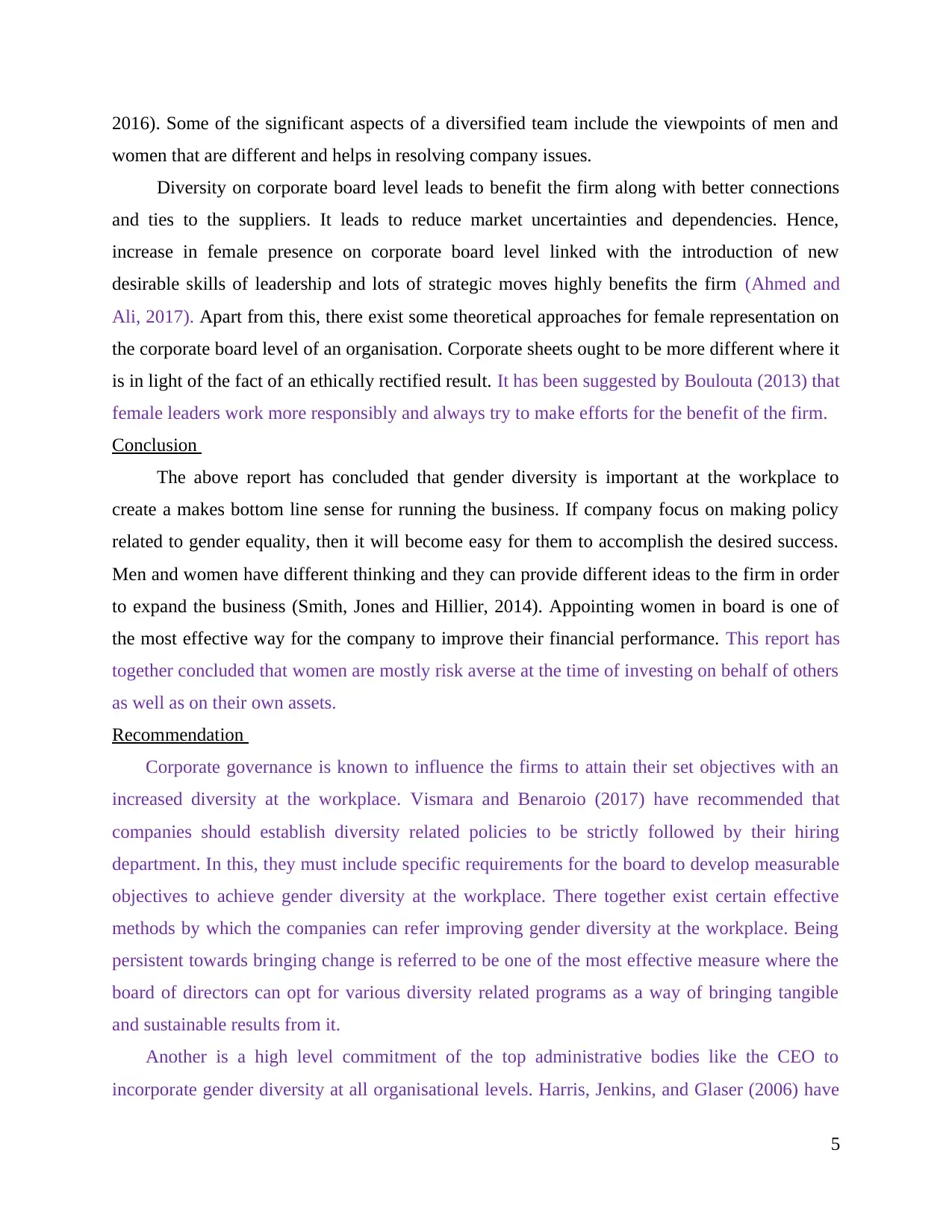
2016). Some of the significant aspects of a diversified team include the viewpoints of men and
women that are different and helps in resolving company issues.
Diversity on corporate board level leads to benefit the firm along with better connections
and ties to the suppliers. It leads to reduce market uncertainties and dependencies. Hence,
increase in female presence on corporate board level linked with the introduction of new
desirable skills of leadership and lots of strategic moves highly benefits the firm (Ahmed and
Ali, 2017). Apart from this, there exist some theoretical approaches for female representation on
the corporate board level of an organisation. Corporate sheets ought to be more different where it
is in light of the fact of an ethically rectified result. It has been suggested by Boulouta (2013) that
female leaders work more responsibly and always try to make efforts for the benefit of the firm.
Conclusion
The above report has concluded that gender diversity is important at the workplace to
create a makes bottom line sense for running the business. If company focus on making policy
related to gender equality, then it will become easy for them to accomplish the desired success.
Men and women have different thinking and they can provide different ideas to the firm in order
to expand the business (Smith, Jones and Hillier, 2014). Appointing women in board is one of
the most effective way for the company to improve their financial performance. This report has
together concluded that women are mostly risk averse at the time of investing on behalf of others
as well as on their own assets.
Recommendation
Corporate governance is known to influence the firms to attain their set objectives with an
increased diversity at the workplace. Vismara and Benaroio (2017) have recommended that
companies should establish diversity related policies to be strictly followed by their hiring
department. In this, they must include specific requirements for the board to develop measurable
objectives to achieve gender diversity at the workplace. There together exist certain effective
methods by which the companies can refer improving gender diversity at the workplace. Being
persistent towards bringing change is referred to be one of the most effective measure where the
board of directors can opt for various diversity related programs as a way of bringing tangible
and sustainable results from it.
Another is a high level commitment of the top administrative bodies like the CEO to
incorporate gender diversity at all organisational levels. Harris, Jenkins, and Glaser (2006) have
5
women that are different and helps in resolving company issues.
Diversity on corporate board level leads to benefit the firm along with better connections
and ties to the suppliers. It leads to reduce market uncertainties and dependencies. Hence,
increase in female presence on corporate board level linked with the introduction of new
desirable skills of leadership and lots of strategic moves highly benefits the firm (Ahmed and
Ali, 2017). Apart from this, there exist some theoretical approaches for female representation on
the corporate board level of an organisation. Corporate sheets ought to be more different where it
is in light of the fact of an ethically rectified result. It has been suggested by Boulouta (2013) that
female leaders work more responsibly and always try to make efforts for the benefit of the firm.
Conclusion
The above report has concluded that gender diversity is important at the workplace to
create a makes bottom line sense for running the business. If company focus on making policy
related to gender equality, then it will become easy for them to accomplish the desired success.
Men and women have different thinking and they can provide different ideas to the firm in order
to expand the business (Smith, Jones and Hillier, 2014). Appointing women in board is one of
the most effective way for the company to improve their financial performance. This report has
together concluded that women are mostly risk averse at the time of investing on behalf of others
as well as on their own assets.
Recommendation
Corporate governance is known to influence the firms to attain their set objectives with an
increased diversity at the workplace. Vismara and Benaroio (2017) have recommended that
companies should establish diversity related policies to be strictly followed by their hiring
department. In this, they must include specific requirements for the board to develop measurable
objectives to achieve gender diversity at the workplace. There together exist certain effective
methods by which the companies can refer improving gender diversity at the workplace. Being
persistent towards bringing change is referred to be one of the most effective measure where the
board of directors can opt for various diversity related programs as a way of bringing tangible
and sustainable results from it.
Another is a high level commitment of the top administrative bodies like the CEO to
incorporate gender diversity at all organisational levels. Harris, Jenkins, and Glaser (2006) have
5
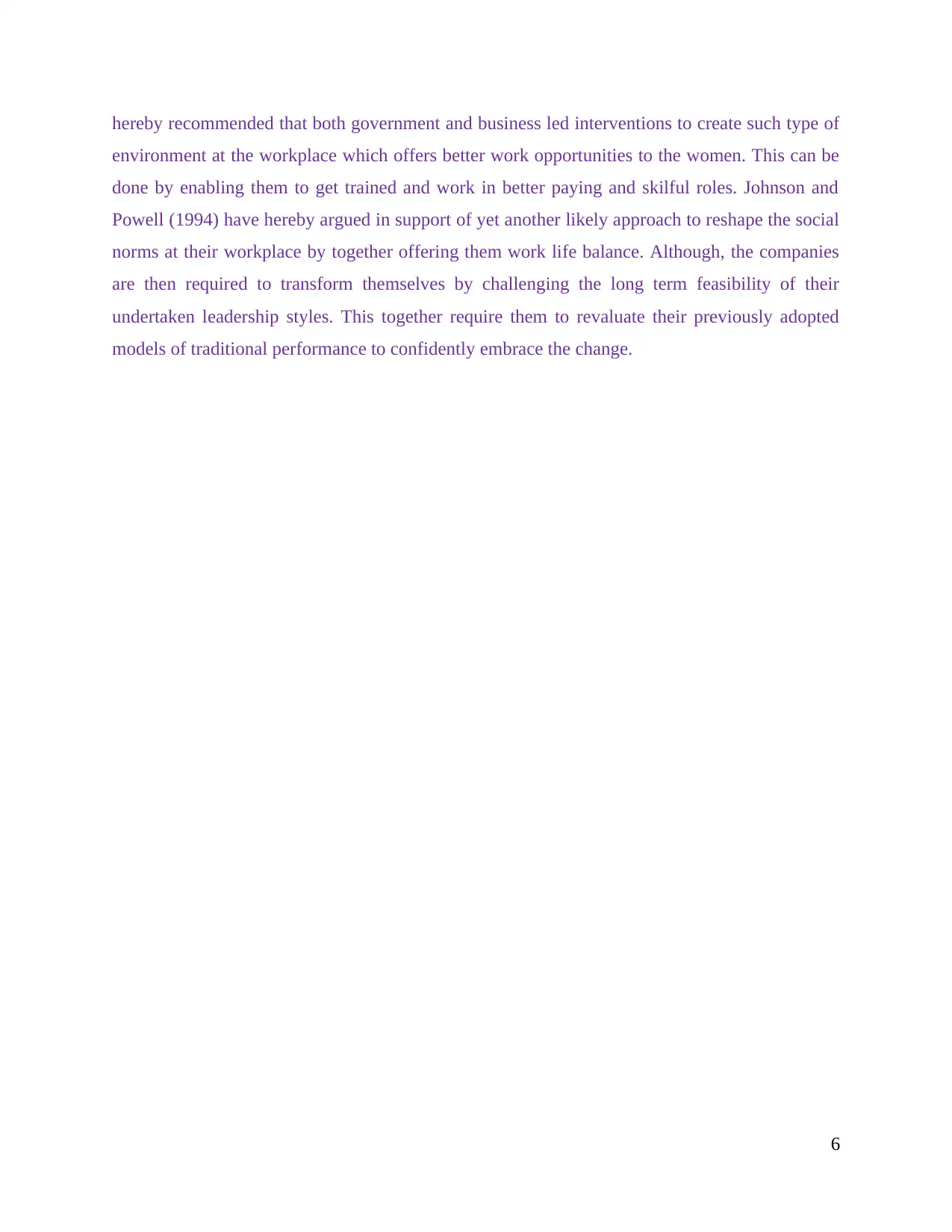
hereby recommended that both government and business led interventions to create such type of
environment at the workplace which offers better work opportunities to the women. This can be
done by enabling them to get trained and work in better paying and skilful roles. Johnson and
Powell (1994) have hereby argued in support of yet another likely approach to reshape the social
norms at their workplace by together offering them work life balance. Although, the companies
are then required to transform themselves by challenging the long term feasibility of their
undertaken leadership styles. This together require them to revaluate their previously adopted
models of traditional performance to confidently embrace the change.
6
environment at the workplace which offers better work opportunities to the women. This can be
done by enabling them to get trained and work in better paying and skilful roles. Johnson and
Powell (1994) have hereby argued in support of yet another likely approach to reshape the social
norms at their workplace by together offering them work life balance. Although, the companies
are then required to transform themselves by challenging the long term feasibility of their
undertaken leadership styles. This together require them to revaluate their previously adopted
models of traditional performance to confidently embrace the change.
6
⊘ This is a preview!⊘
Do you want full access?
Subscribe today to unlock all pages.

Trusted by 1+ million students worldwide
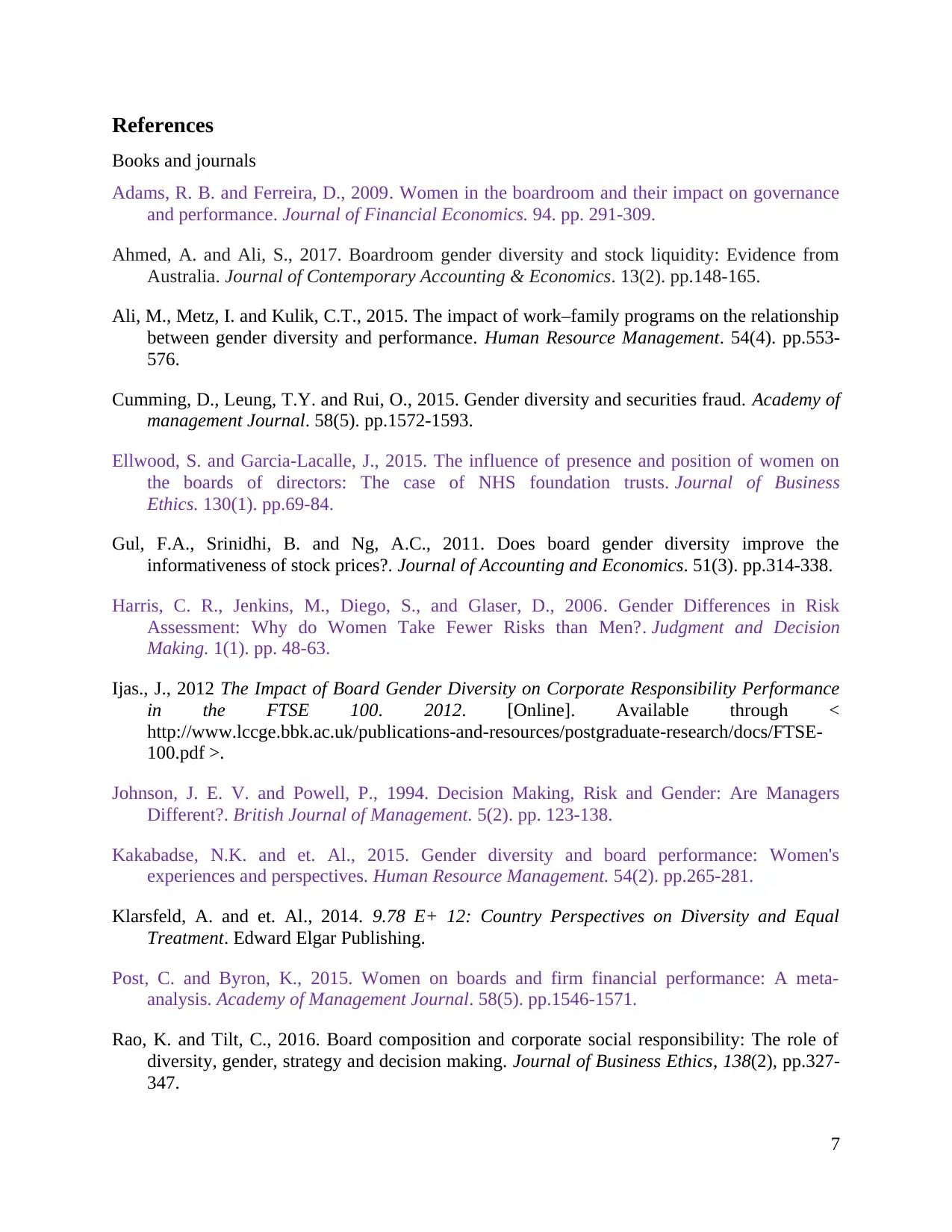
References
Books and journals
Adams, R. B. and Ferreira, D., 2009. Women in the boardroom and their impact on governance
and performance. Journal of Financial Economics. 94. pp. 291-309.
Ahmed, A. and Ali, S., 2017. Boardroom gender diversity and stock liquidity: Evidence from
Australia. Journal of Contemporary Accounting & Economics. 13(2). pp.148-165.
Ali, M., Metz, I. and Kulik, C.T., 2015. The impact of work–family programs on the relationship
between gender diversity and performance. Human Resource Management. 54(4). pp.553-
576.
Cumming, D., Leung, T.Y. and Rui, O., 2015. Gender diversity and securities fraud. Academy of
management Journal. 58(5). pp.1572-1593.
Ellwood, S. and Garcia-Lacalle, J., 2015. The influence of presence and position of women on
the boards of directors: The case of NHS foundation trusts. Journal of Business
Ethics. 130(1). pp.69-84.
Gul, F.A., Srinidhi, B. and Ng, A.C., 2011. Does board gender diversity improve the
informativeness of stock prices?. Journal of Accounting and Economics. 51(3). pp.314-338.
Harris, C. R., Jenkins, M., Diego, S., and Glaser, D., 2006. Gender Differences in Risk
Assessment: Why do Women Take Fewer Risks than Men?. Judgment and Decision
Making. 1(1). pp. 48-63.
Ijas., J., 2012 The Impact of Board Gender Diversity on Corporate Responsibility Performance
in the FTSE 100. 2012. [Online]. Available through <
http://www.lccge.bbk.ac.uk/publications-and-resources/postgraduate-research/docs/FTSE-
100.pdf >.
Johnson, J. E. V. and Powell, P., 1994. Decision Making, Risk and Gender: Are Managers
Different?. British Journal of Management. 5(2). pp. 123-138.
Kakabadse, N.K. and et. Al., 2015. Gender diversity and board performance: Women's
experiences and perspectives. Human Resource Management. 54(2). pp.265-281.
Klarsfeld, A. and et. Al., 2014. 9.78 E+ 12: Country Perspectives on Diversity and Equal
Treatment. Edward Elgar Publishing.
Post, C. and Byron, K., 2015. Women on boards and firm financial performance: A meta-
analysis. Academy of Management Journal. 58(5). pp.1546-1571.
Rao, K. and Tilt, C., 2016. Board composition and corporate social responsibility: The role of
diversity, gender, strategy and decision making. Journal of Business Ethics, 138(2), pp.327-
347.
7
Books and journals
Adams, R. B. and Ferreira, D., 2009. Women in the boardroom and their impact on governance
and performance. Journal of Financial Economics. 94. pp. 291-309.
Ahmed, A. and Ali, S., 2017. Boardroom gender diversity and stock liquidity: Evidence from
Australia. Journal of Contemporary Accounting & Economics. 13(2). pp.148-165.
Ali, M., Metz, I. and Kulik, C.T., 2015. The impact of work–family programs on the relationship
between gender diversity and performance. Human Resource Management. 54(4). pp.553-
576.
Cumming, D., Leung, T.Y. and Rui, O., 2015. Gender diversity and securities fraud. Academy of
management Journal. 58(5). pp.1572-1593.
Ellwood, S. and Garcia-Lacalle, J., 2015. The influence of presence and position of women on
the boards of directors: The case of NHS foundation trusts. Journal of Business
Ethics. 130(1). pp.69-84.
Gul, F.A., Srinidhi, B. and Ng, A.C., 2011. Does board gender diversity improve the
informativeness of stock prices?. Journal of Accounting and Economics. 51(3). pp.314-338.
Harris, C. R., Jenkins, M., Diego, S., and Glaser, D., 2006. Gender Differences in Risk
Assessment: Why do Women Take Fewer Risks than Men?. Judgment and Decision
Making. 1(1). pp. 48-63.
Ijas., J., 2012 The Impact of Board Gender Diversity on Corporate Responsibility Performance
in the FTSE 100. 2012. [Online]. Available through <
http://www.lccge.bbk.ac.uk/publications-and-resources/postgraduate-research/docs/FTSE-
100.pdf >.
Johnson, J. E. V. and Powell, P., 1994. Decision Making, Risk and Gender: Are Managers
Different?. British Journal of Management. 5(2). pp. 123-138.
Kakabadse, N.K. and et. Al., 2015. Gender diversity and board performance: Women's
experiences and perspectives. Human Resource Management. 54(2). pp.265-281.
Klarsfeld, A. and et. Al., 2014. 9.78 E+ 12: Country Perspectives on Diversity and Equal
Treatment. Edward Elgar Publishing.
Post, C. and Byron, K., 2015. Women on boards and firm financial performance: A meta-
analysis. Academy of Management Journal. 58(5). pp.1546-1571.
Rao, K. and Tilt, C., 2016. Board composition and corporate social responsibility: The role of
diversity, gender, strategy and decision making. Journal of Business Ethics, 138(2), pp.327-
347.
7
Paraphrase This Document
Need a fresh take? Get an instant paraphrase of this document with our AI Paraphraser
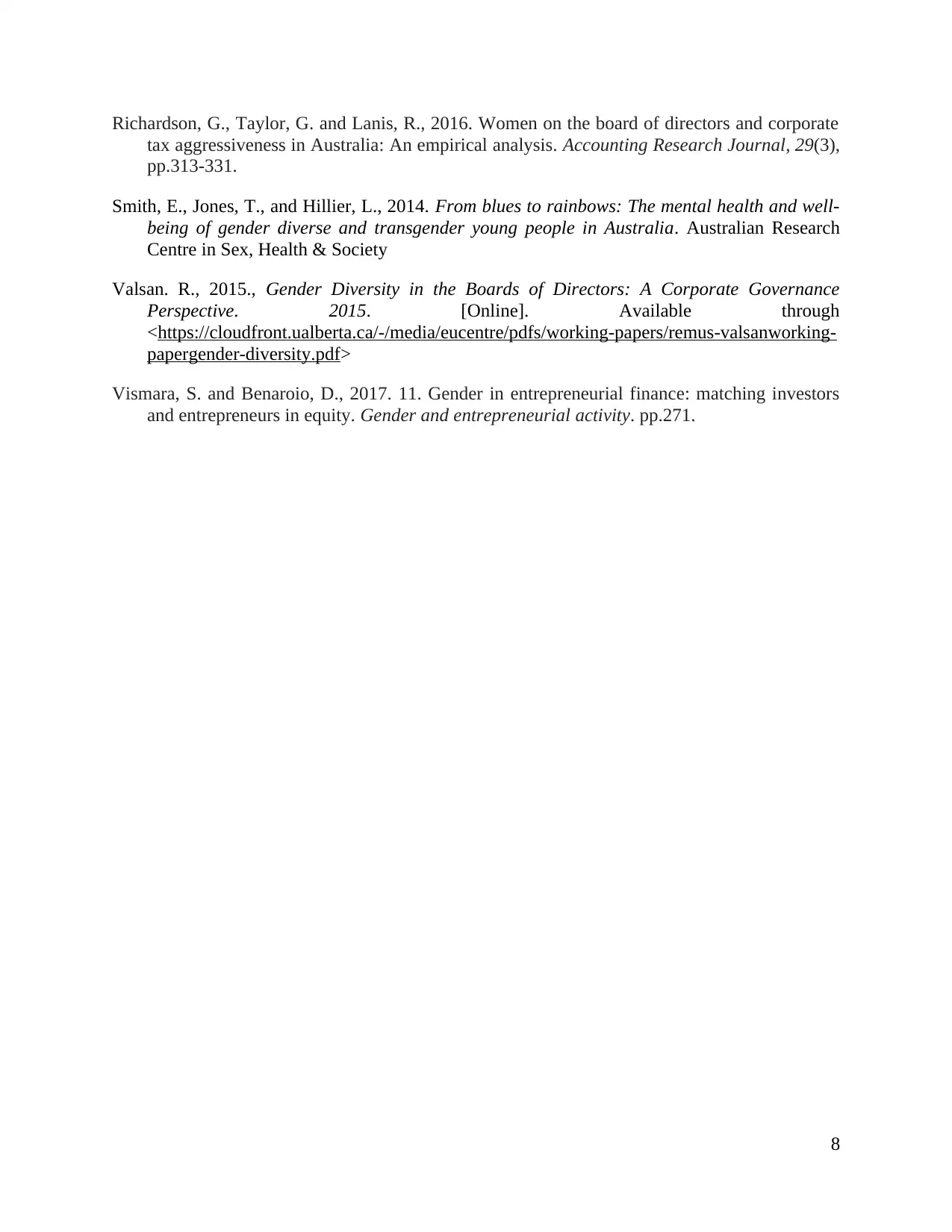
Richardson, G., Taylor, G. and Lanis, R., 2016. Women on the board of directors and corporate
tax aggressiveness in Australia: An empirical analysis. Accounting Research Journal, 29(3),
pp.313-331.
Smith, E., Jones, T., and Hillier, L., 2014. From blues to rainbows: The mental health and well-
being of gender diverse and transgender young people in Australia. Australian Research
Centre in Sex, Health & Society
Valsan. R., 2015., Gender Diversity in the Boards of Directors: A Corporate Governance
Perspective. 2015. [Online]. Available through
<https://cloudfront.ualberta.ca/-/media/eucentre/pdfs/working-papers/remus-valsanworking-
papergender-diversity.pdf>
Vismara, S. and Benaroio, D., 2017. 11. Gender in entrepreneurial finance: matching investors
and entrepreneurs in equity. Gender and entrepreneurial activity. pp.271.
8
tax aggressiveness in Australia: An empirical analysis. Accounting Research Journal, 29(3),
pp.313-331.
Smith, E., Jones, T., and Hillier, L., 2014. From blues to rainbows: The mental health and well-
being of gender diverse and transgender young people in Australia. Australian Research
Centre in Sex, Health & Society
Valsan. R., 2015., Gender Diversity in the Boards of Directors: A Corporate Governance
Perspective. 2015. [Online]. Available through
<https://cloudfront.ualberta.ca/-/media/eucentre/pdfs/working-papers/remus-valsanworking-
papergender-diversity.pdf>
Vismara, S. and Benaroio, D., 2017. 11. Gender in entrepreneurial finance: matching investors
and entrepreneurs in equity. Gender and entrepreneurial activity. pp.271.
8
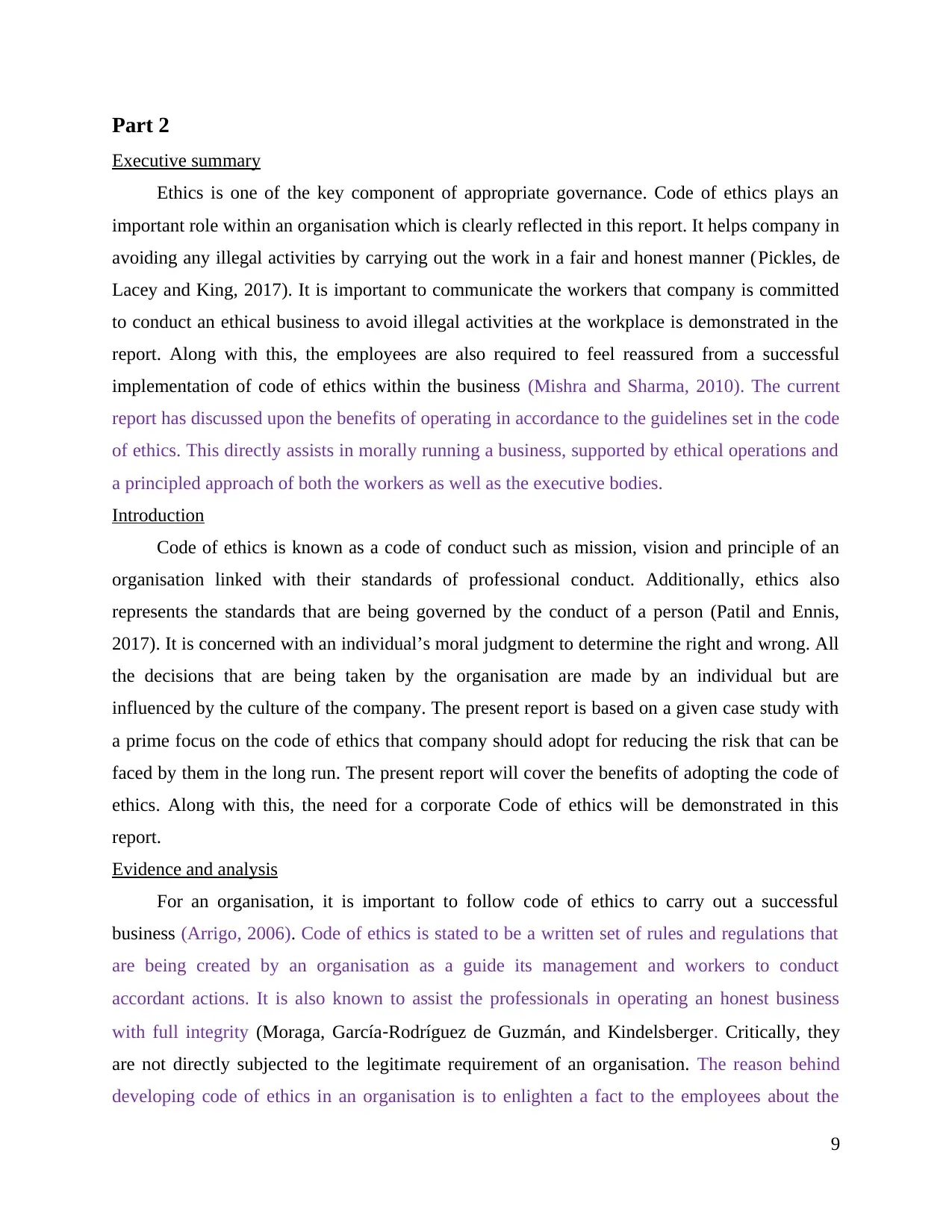
Part 2
Executive summary
Ethics is one of the key component of appropriate governance. Code of ethics plays an
important role within an organisation which is clearly reflected in this report. It helps company in
avoiding any illegal activities by carrying out the work in a fair and honest manner (Pickles, de
Lacey and King, 2017). It is important to communicate the workers that company is committed
to conduct an ethical business to avoid illegal activities at the workplace is demonstrated in the
report. Along with this, the employees are also required to feel reassured from a successful
implementation of code of ethics within the business (Mishra and Sharma, 2010). The current
report has discussed upon the benefits of operating in accordance to the guidelines set in the code
of ethics. This directly assists in morally running a business, supported by ethical operations and
a principled approach of both the workers as well as the executive bodies.
Introduction
Code of ethics is known as a code of conduct such as mission, vision and principle of an
organisation linked with their standards of professional conduct. Additionally, ethics also
represents the standards that are being governed by the conduct of a person (Patil and Ennis,
2017). It is concerned with an individual’s moral judgment to determine the right and wrong. All
the decisions that are being taken by the organisation are made by an individual but are
influenced by the culture of the company. The present report is based on a given case study with
a prime focus on the code of ethics that company should adopt for reducing the risk that can be
faced by them in the long run. The present report will cover the benefits of adopting the code of
ethics. Along with this, the need for a corporate Code of ethics will be demonstrated in this
report.
Evidence and analysis
For an organisation, it is important to follow code of ethics to carry out a successful
business (Arrigo, 2006). Code of ethics is stated to be a written set of rules and regulations that
are being created by an organisation as a guide its management and workers to conduct
accordant actions. It is also known to assist the professionals in operating an honest business
with full integrity (Moraga, García‐Rodríguez de Guzmán, and Kindelsberger. Critically, they
are not directly subjected to the legitimate requirement of an organisation. The reason behind
developing code of ethics in an organisation is to enlighten a fact to the employees about the
9
Executive summary
Ethics is one of the key component of appropriate governance. Code of ethics plays an
important role within an organisation which is clearly reflected in this report. It helps company in
avoiding any illegal activities by carrying out the work in a fair and honest manner (Pickles, de
Lacey and King, 2017). It is important to communicate the workers that company is committed
to conduct an ethical business to avoid illegal activities at the workplace is demonstrated in the
report. Along with this, the employees are also required to feel reassured from a successful
implementation of code of ethics within the business (Mishra and Sharma, 2010). The current
report has discussed upon the benefits of operating in accordance to the guidelines set in the code
of ethics. This directly assists in morally running a business, supported by ethical operations and
a principled approach of both the workers as well as the executive bodies.
Introduction
Code of ethics is known as a code of conduct such as mission, vision and principle of an
organisation linked with their standards of professional conduct. Additionally, ethics also
represents the standards that are being governed by the conduct of a person (Patil and Ennis,
2017). It is concerned with an individual’s moral judgment to determine the right and wrong. All
the decisions that are being taken by the organisation are made by an individual but are
influenced by the culture of the company. The present report is based on a given case study with
a prime focus on the code of ethics that company should adopt for reducing the risk that can be
faced by them in the long run. The present report will cover the benefits of adopting the code of
ethics. Along with this, the need for a corporate Code of ethics will be demonstrated in this
report.
Evidence and analysis
For an organisation, it is important to follow code of ethics to carry out a successful
business (Arrigo, 2006). Code of ethics is stated to be a written set of rules and regulations that
are being created by an organisation as a guide its management and workers to conduct
accordant actions. It is also known to assist the professionals in operating an honest business
with full integrity (Moraga, García‐Rodríguez de Guzmán, and Kindelsberger. Critically, they
are not directly subjected to the legitimate requirement of an organisation. The reason behind
developing code of ethics in an organisation is to enlighten a fact to the employees about the
9
⊘ This is a preview!⊘
Do you want full access?
Subscribe today to unlock all pages.

Trusted by 1+ million students worldwide
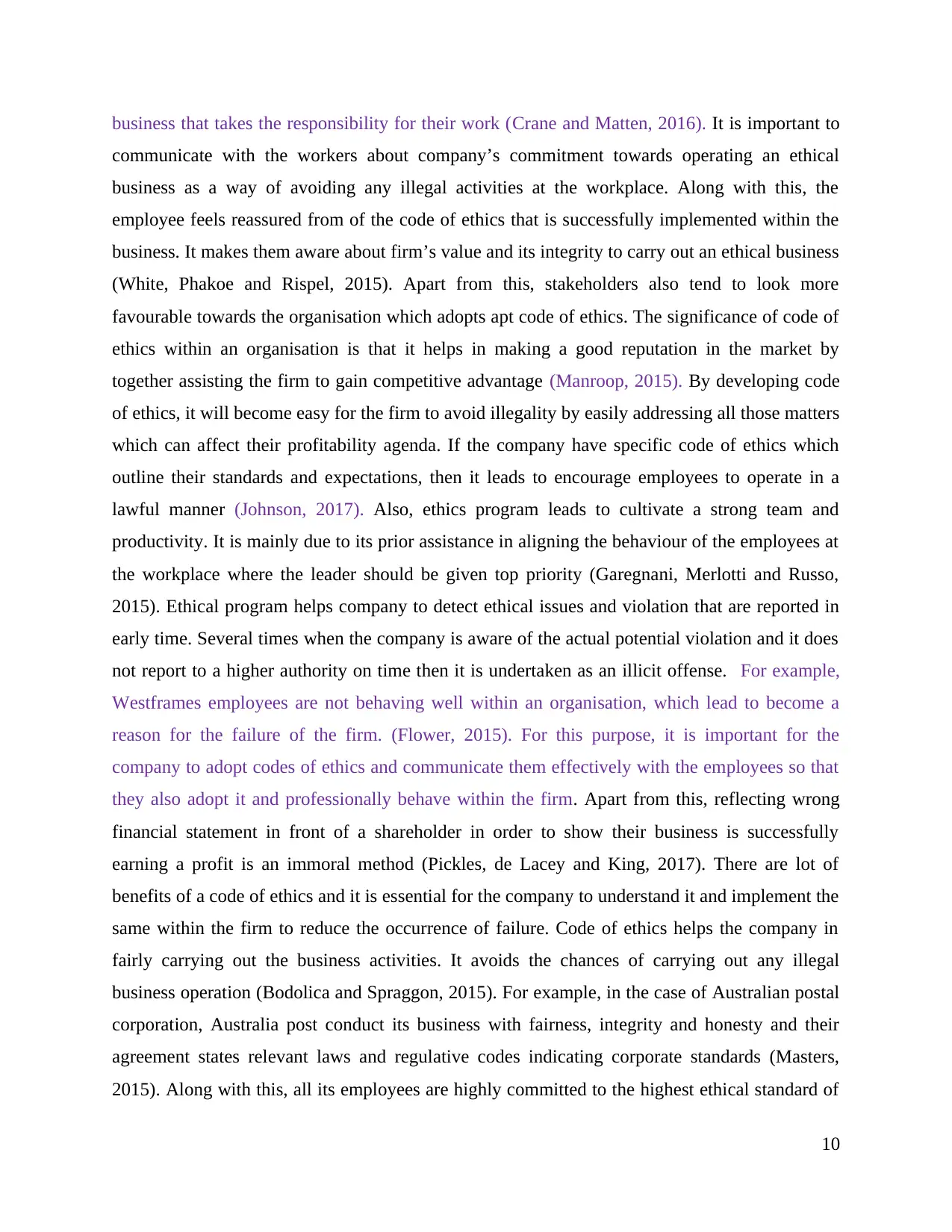
business that takes the responsibility for their work (Crane and Matten, 2016). It is important to
communicate with the workers about company’s commitment towards operating an ethical
business as a way of avoiding any illegal activities at the workplace. Along with this, the
employee feels reassured from of the code of ethics that is successfully implemented within the
business. It makes them aware about firm’s value and its integrity to carry out an ethical business
(White, Phakoe and Rispel, 2015). Apart from this, stakeholders also tend to look more
favourable towards the organisation which adopts apt code of ethics. The significance of code of
ethics within an organisation is that it helps in making a good reputation in the market by
together assisting the firm to gain competitive advantage (Manroop, 2015). By developing code
of ethics, it will become easy for the firm to avoid illegality by easily addressing all those matters
which can affect their profitability agenda. If the company have specific code of ethics which
outline their standards and expectations, then it leads to encourage employees to operate in a
lawful manner (Johnson, 2017). Also, ethics program leads to cultivate a strong team and
productivity. It is mainly due to its prior assistance in aligning the behaviour of the employees at
the workplace where the leader should be given top priority (Garegnani, Merlotti and Russo,
2015). Ethical program helps company to detect ethical issues and violation that are reported in
early time. Several times when the company is aware of the actual potential violation and it does
not report to a higher authority on time then it is undertaken as an illicit offense. For example,
Westframes employees are not behaving well within an organisation, which lead to become a
reason for the failure of the firm. (Flower, 2015). For this purpose, it is important for the
company to adopt codes of ethics and communicate them effectively with the employees so that
they also adopt it and professionally behave within the firm. Apart from this, reflecting wrong
financial statement in front of a shareholder in order to show their business is successfully
earning a profit is an immoral method (Pickles, de Lacey and King, 2017). There are lot of
benefits of a code of ethics and it is essential for the company to understand it and implement the
same within the firm to reduce the occurrence of failure. Code of ethics helps the company in
fairly carrying out the business activities. It avoids the chances of carrying out any illegal
business operation (Bodolica and Spraggon, 2015). For example, in the case of Australian postal
corporation, Australia post conduct its business with fairness, integrity and honesty and their
agreement states relevant laws and regulative codes indicating corporate standards (Masters,
2015). Along with this, all its employees are highly committed to the highest ethical standard of
10
communicate with the workers about company’s commitment towards operating an ethical
business as a way of avoiding any illegal activities at the workplace. Along with this, the
employee feels reassured from of the code of ethics that is successfully implemented within the
business. It makes them aware about firm’s value and its integrity to carry out an ethical business
(White, Phakoe and Rispel, 2015). Apart from this, stakeholders also tend to look more
favourable towards the organisation which adopts apt code of ethics. The significance of code of
ethics within an organisation is that it helps in making a good reputation in the market by
together assisting the firm to gain competitive advantage (Manroop, 2015). By developing code
of ethics, it will become easy for the firm to avoid illegality by easily addressing all those matters
which can affect their profitability agenda. If the company have specific code of ethics which
outline their standards and expectations, then it leads to encourage employees to operate in a
lawful manner (Johnson, 2017). Also, ethics program leads to cultivate a strong team and
productivity. It is mainly due to its prior assistance in aligning the behaviour of the employees at
the workplace where the leader should be given top priority (Garegnani, Merlotti and Russo,
2015). Ethical program helps company to detect ethical issues and violation that are reported in
early time. Several times when the company is aware of the actual potential violation and it does
not report to a higher authority on time then it is undertaken as an illicit offense. For example,
Westframes employees are not behaving well within an organisation, which lead to become a
reason for the failure of the firm. (Flower, 2015). For this purpose, it is important for the
company to adopt codes of ethics and communicate them effectively with the employees so that
they also adopt it and professionally behave within the firm. Apart from this, reflecting wrong
financial statement in front of a shareholder in order to show their business is successfully
earning a profit is an immoral method (Pickles, de Lacey and King, 2017). There are lot of
benefits of a code of ethics and it is essential for the company to understand it and implement the
same within the firm to reduce the occurrence of failure. Code of ethics helps the company in
fairly carrying out the business activities. It avoids the chances of carrying out any illegal
business operation (Bodolica and Spraggon, 2015). For example, in the case of Australian postal
corporation, Australia post conduct its business with fairness, integrity and honesty and their
agreement states relevant laws and regulative codes indicating corporate standards (Masters,
2015). Along with this, all its employees are highly committed to the highest ethical standard of
10
Paraphrase This Document
Need a fresh take? Get an instant paraphrase of this document with our AI Paraphraser
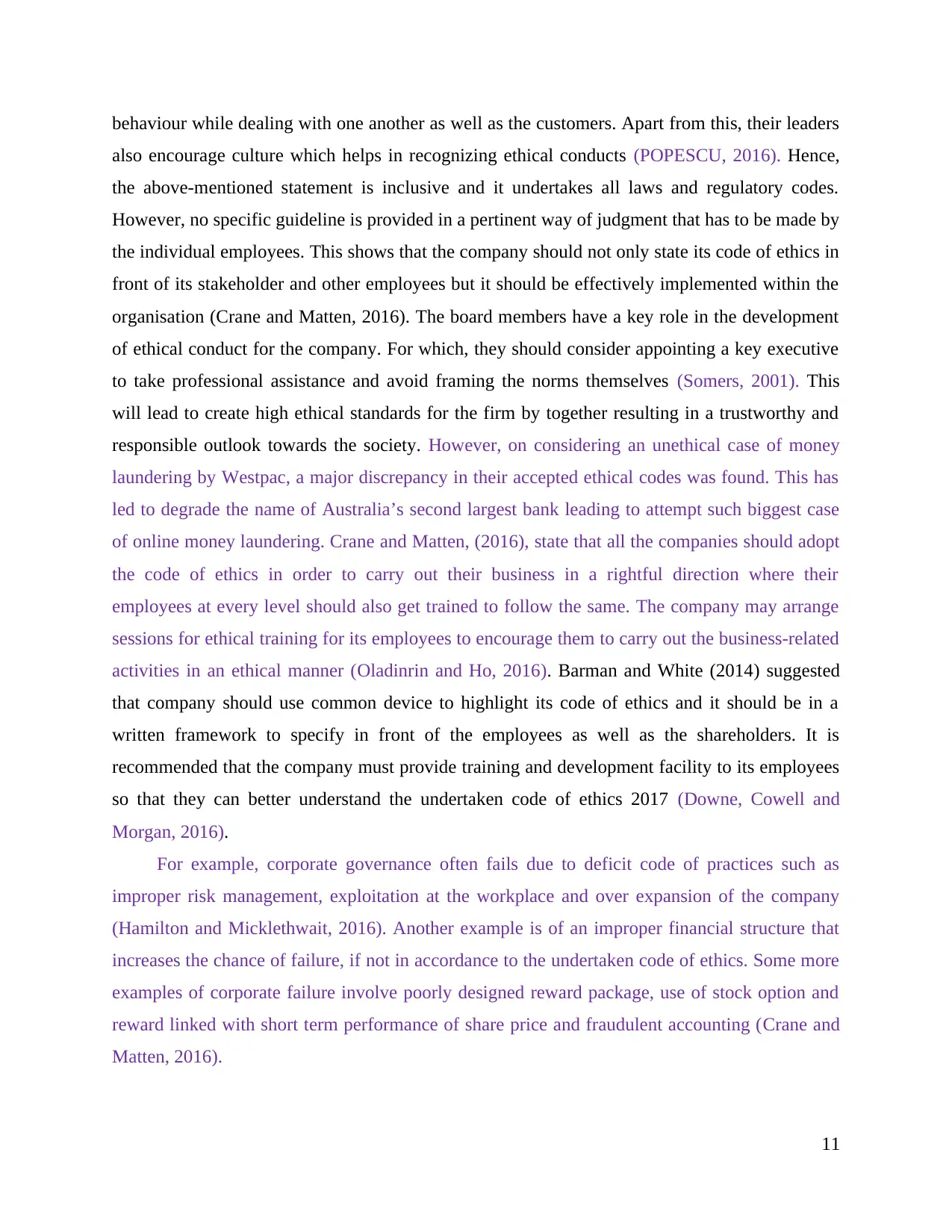
behaviour while dealing with one another as well as the customers. Apart from this, their leaders
also encourage culture which helps in recognizing ethical conducts (POPESCU, 2016). Hence,
the above-mentioned statement is inclusive and it undertakes all laws and regulatory codes.
However, no specific guideline is provided in a pertinent way of judgment that has to be made by
the individual employees. This shows that the company should not only state its code of ethics in
front of its stakeholder and other employees but it should be effectively implemented within the
organisation (Crane and Matten, 2016). The board members have a key role in the development
of ethical conduct for the company. For which, they should consider appointing a key executive
to take professional assistance and avoid framing the norms themselves (Somers, 2001). This
will lead to create high ethical standards for the firm by together resulting in a trustworthy and
responsible outlook towards the society. However, on considering an unethical case of money
laundering by Westpac, a major discrepancy in their accepted ethical codes was found. This has
led to degrade the name of Australia’s second largest bank leading to attempt such biggest case
of online money laundering. Crane and Matten, (2016), state that all the companies should adopt
the code of ethics in order to carry out their business in a rightful direction where their
employees at every level should also get trained to follow the same. The company may arrange
sessions for ethical training for its employees to encourage them to carry out the business-related
activities in an ethical manner (Oladinrin and Ho, 2016). Barman and White (2014) suggested
that company should use common device to highlight its code of ethics and it should be in a
written framework to specify in front of the employees as well as the shareholders. It is
recommended that the company must provide training and development facility to its employees
so that they can better understand the undertaken code of ethics 2017 (Downe, Cowell and
Morgan, 2016).
For example, corporate governance often fails due to deficit code of practices such as
improper risk management, exploitation at the workplace and over expansion of the company
(Hamilton and Micklethwait, 2016). Another example is of an improper financial structure that
increases the chance of failure, if not in accordance to the undertaken code of ethics. Some more
examples of corporate failure involve poorly designed reward package, use of stock option and
reward linked with short term performance of share price and fraudulent accounting (Crane and
Matten, 2016).
11
also encourage culture which helps in recognizing ethical conducts (POPESCU, 2016). Hence,
the above-mentioned statement is inclusive and it undertakes all laws and regulatory codes.
However, no specific guideline is provided in a pertinent way of judgment that has to be made by
the individual employees. This shows that the company should not only state its code of ethics in
front of its stakeholder and other employees but it should be effectively implemented within the
organisation (Crane and Matten, 2016). The board members have a key role in the development
of ethical conduct for the company. For which, they should consider appointing a key executive
to take professional assistance and avoid framing the norms themselves (Somers, 2001). This
will lead to create high ethical standards for the firm by together resulting in a trustworthy and
responsible outlook towards the society. However, on considering an unethical case of money
laundering by Westpac, a major discrepancy in their accepted ethical codes was found. This has
led to degrade the name of Australia’s second largest bank leading to attempt such biggest case
of online money laundering. Crane and Matten, (2016), state that all the companies should adopt
the code of ethics in order to carry out their business in a rightful direction where their
employees at every level should also get trained to follow the same. The company may arrange
sessions for ethical training for its employees to encourage them to carry out the business-related
activities in an ethical manner (Oladinrin and Ho, 2016). Barman and White (2014) suggested
that company should use common device to highlight its code of ethics and it should be in a
written framework to specify in front of the employees as well as the shareholders. It is
recommended that the company must provide training and development facility to its employees
so that they can better understand the undertaken code of ethics 2017 (Downe, Cowell and
Morgan, 2016).
For example, corporate governance often fails due to deficit code of practices such as
improper risk management, exploitation at the workplace and over expansion of the company
(Hamilton and Micklethwait, 2016). Another example is of an improper financial structure that
increases the chance of failure, if not in accordance to the undertaken code of ethics. Some more
examples of corporate failure involve poorly designed reward package, use of stock option and
reward linked with short term performance of share price and fraudulent accounting (Crane and
Matten, 2016).
11
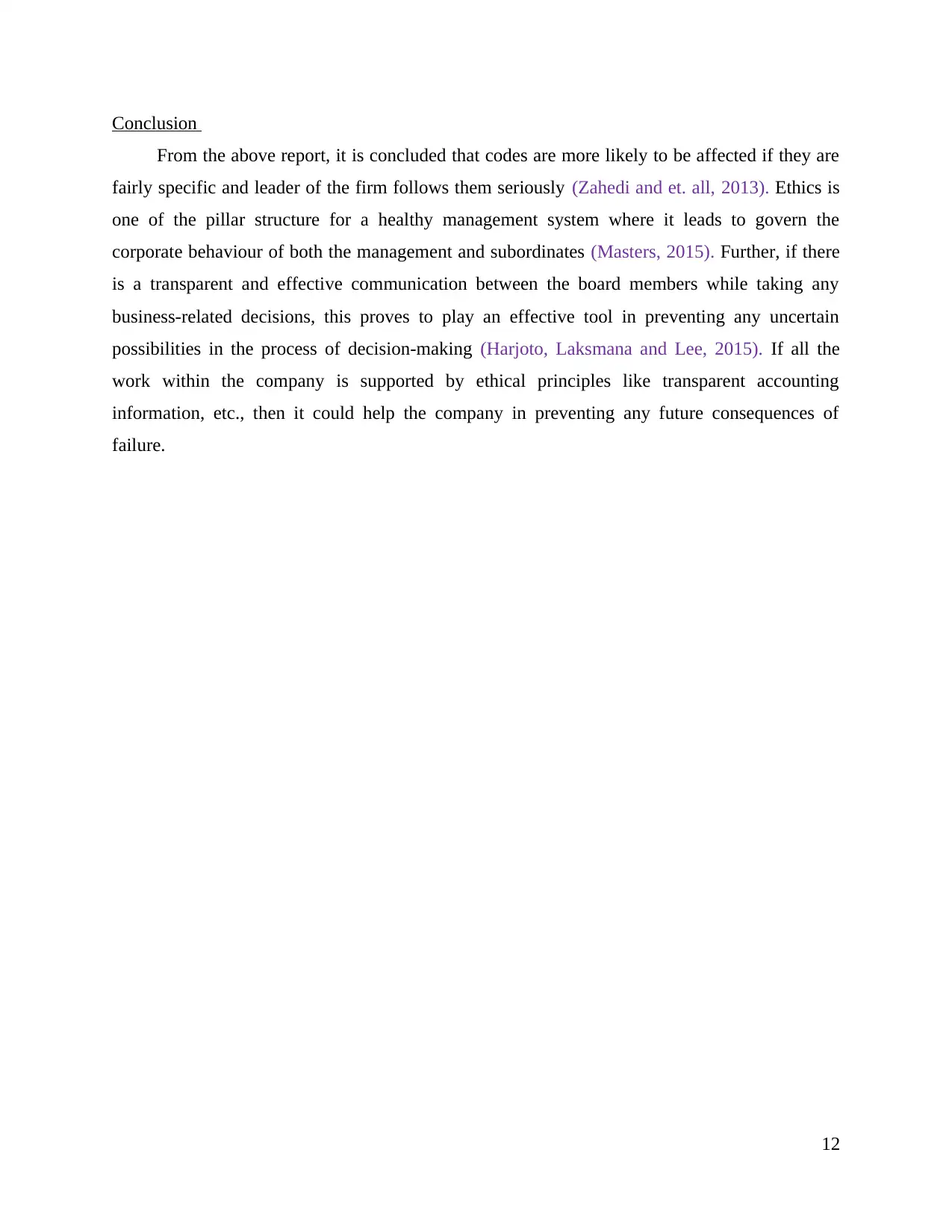
Conclusion
From the above report, it is concluded that codes are more likely to be affected if they are
fairly specific and leader of the firm follows them seriously (Zahedi and et. all, 2013). Ethics is
one of the pillar structure for a healthy management system where it leads to govern the
corporate behaviour of both the management and subordinates (Masters, 2015). Further, if there
is a transparent and effective communication between the board members while taking any
business-related decisions, this proves to play an effective tool in preventing any uncertain
possibilities in the process of decision-making (Harjoto, Laksmana and Lee, 2015). If all the
work within the company is supported by ethical principles like transparent accounting
information, etc., then it could help the company in preventing any future consequences of
failure.
12
From the above report, it is concluded that codes are more likely to be affected if they are
fairly specific and leader of the firm follows them seriously (Zahedi and et. all, 2013). Ethics is
one of the pillar structure for a healthy management system where it leads to govern the
corporate behaviour of both the management and subordinates (Masters, 2015). Further, if there
is a transparent and effective communication between the board members while taking any
business-related decisions, this proves to play an effective tool in preventing any uncertain
possibilities in the process of decision-making (Harjoto, Laksmana and Lee, 2015). If all the
work within the company is supported by ethical principles like transparent accounting
information, etc., then it could help the company in preventing any future consequences of
failure.
12
⊘ This is a preview!⊘
Do you want full access?
Subscribe today to unlock all pages.

Trusted by 1+ million students worldwide
1 out of 16
Related Documents
Your All-in-One AI-Powered Toolkit for Academic Success.
+13062052269
info@desklib.com
Available 24*7 on WhatsApp / Email
![[object Object]](/_next/static/media/star-bottom.7253800d.svg)
Unlock your academic potential
Copyright © 2020–2025 A2Z Services. All Rights Reserved. Developed and managed by ZUCOL.





